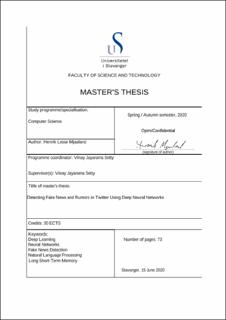| dc.contributor.advisor | Setty, Vinay | |
| dc.contributor.author | Mjaaland, Henrik | |
| dc.date.accessioned | 2020-09-27T18:50:33Z | |
| dc.date.available | 2020-09-27T18:50:33Z | |
| dc.date.issued | 2020-06-15 | |
| dc.identifier.uri | https://hdl.handle.net/11250/2679792 | |
| dc.description | Master's thesis in Computer Science. | en_US |
| dc.description.abstract | The scope of this thesis is to detect fake news by classifying them as either real or fake based on article content, metadata, tweets and retweets of news articles from the Politifact dataset using graph neural networks.
Fake news generally spread exponentially and more rapid than real news. This is most likely because fake news are usually more novel or dramatic and contain more superlatives than real news. Fake tweets also tend to have more rumor path propagation hops than real news, meaning tweets of fake news are retweeted more than real news. Tweets of real news articles on the other hand, tend to have a constant and slow spread, and does not reach as many people overall.
There are generally two characteristics that are used for detecting fake news: article content and rumor path propagation. Most existing works have presented models based solely on one of these characteristics, which has its advantages (e.g. reduced training time), but is also reflected by poor performance results.
This thesis proposes a hybrid model that takes metadata and both of the above mentioned characteristics (article content and rumor path propagation in the form of a temporal pattern) as input using bidirectional LSTM with the Keras Sequential model. Article content is word embedded using pre trained GloVe vectors. The metadata, which is continuous, is normalized and discretized. The rumor path propagation time series is computed using dates from metadata related to tweets and retweets.
Some other deep learning and machine learning models are also implemented and tested for comparison. Experimental results demonstrated that the proposed model performs significantly better than all of these models. | en_US |
| dc.language.iso | eng | en_US |
| dc.publisher | University of Stavanger, Norway | en_US |
| dc.relation.ispartofseries | Masteroppgave/UIS-TN-IDE/2020; | |
| dc.rights | Navngivelse 4.0 Internasjonal | * |
| dc.rights | Navngivelse 4.0 Internasjonal | * |
| dc.rights | Navngivelse 4.0 Internasjonal | * |
| dc.rights | Navngivelse 4.0 Internasjonal | * |
| dc.rights | Navngivelse 4.0 Internasjonal | * |
| dc.rights.uri | http://creativecommons.org/licenses/by/4.0/deed.no | * |
| dc.subject | informasjonsteknologi | en_US |
| dc.subject | computer science | en_US |
| dc.subject | deep learning | en_US |
| dc.subject | neural networks | en_US |
| dc.subject | fake news detection | en_US |
| dc.subject | natural language processing | en_US |
| dc.subject | long short-term memory | en_US |
| dc.subject | datateknikk | en_US |
| dc.title | Detecting Fake News and Rumors in Twitter Using Deep Neural Networks | en_US |
| dc.type | Master thesis | en_US |
| dc.description.version | submittedVersion | en_US |
| dc.subject.nsi | VDP::Teknologi: 500::Informasjons- og kommunikasjonsteknologi: 550 | en_US |

